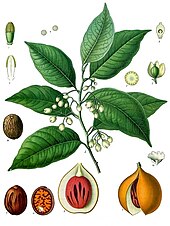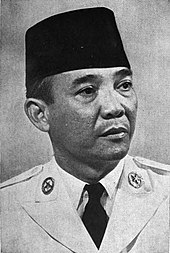A blog in my earlier site had explored Indonesia. Decided to write up something again:
The History of Indonesia or more precisely of the Indonesian archipelago in South East Asia with 17,508 islands goes back to Homo erectus (popularly known as the “Java Man”). There have been found fossilized remains of about one million years ago.[1]
Austronesian people, who form the majority of the modern population, came to South East Asia from Taiwan. They arrived in Indonesia around 2000 BCE. The native Melanesian peoples went to the far eastern regions.[2] The agricultural conditions were very good. When wet-field rice cultivation was developed as early as the eighth century BCE,[3] villages and towns developed. And small kingdoms began to flourish by the first century CE. Indonesia’s sea-lane position helped international trade. There was trade with both Indian kingdoms and China already several centuries BCE.[4] Trade has since fundamentally shaped Indonesian history.[5]

The nutmeg plant is native to Indonesia’s Banda Islands. It is so valuable, that European colonial powers were attacted to Indonesia.
From the seventh century CE, the powerful Srivijaya naval kingdom flourished as a result of trade. Hinduism and Buddhism were imported with it.[6] In the late 13th century, the Hindu Majapahit kingdom was founded in eastern Java and under Gajah Mada, its influence stretched over much of Indonesia; this period is often referred to as a “Golden Age” in Indonesian history.[7]
During the 13th century Islam spread to the in northern Sumatra.[8] More and more Indonesian areas gradually adopted Islam. By the end of the 16th century it was the dominant religion in Java and Sumatra. But it mixed with existing cultural and religious influences.[9]
The first Europeans arrived in Indonesia in 1512, when Portuguese traders, led by Francisco Serrão, sought to monopolize the sources of nutmeg, cloves, and cubeb pepper in Maluku.[10] Dutch and British traders followed. In 1602 the Dutch established the Dutch East India Company (VOC) and became the dominant European power. But Dutch control stretched not very far. Only in the early 20th century it extended to borders of today.

Sukarno, Indonesia’s founding president
During the Second World War the Dutch lost control and in August 1945, Sukarno, an influential nationalist leader, declared independence and was appointed president.[11] After some fights the Netherlands formally recognized Indonesian independence in December 1949[12] (with the exception of The Dutch territory of West New Guinea).
Sukarno moved from democracy towards dictatorship. But Sukarno lost power to the head of the military, General Suharto who was formally appointed president in March 1968. He was supported by the US government,[13] and encouraged foreign direct investment in Indonesia, which helped economic growth during the following thirty years.[14] But his rule went along with corruption and suppression of political opposition.
In 1997 and 1998, Indonesia was the country hardest hit by the Asian Financial Crisis.[15] This increased popular discontent with the New Order[16] and led to popular protests. Suharto resigned on 21 May 1998.[17] In 1999, East Timor voted to leave the state of Indonesia, after a twenty-five-year military occupation.[18] After Suharto’s resignation democracy improved. A regional autonomy program was introduced, and the first direct presidential election took place in 2004. But some political and economic instability has remained.[19] A political settlement to an armed separatist conflict in Aceh was achieved in 2005.[20]
The history of Indonesia has been shaped by its geographic position, its natural resources, a series of human migrations and contacts, wars and conquests, as well as by trade, economics and politics. Indonesia is an archipelagiccountry of 17,000 to 18,000 islands (8,844 named and 922 permanently inhabited) stretching along the equator in South East Asia. The country’s strategic sea-lane position fostered inter-island and international trade; trade has since fundamentally shaped Indonesian history. The area of Indonesia is populated by peoples of various migrations, creating a diversity of cultures, ethnicities, and languages. The archipelago’s landforms and climate significantly influenced agriculture and trade, and the formation of states. The boundaries of the state of Indonesia represent the 20th century borders of the Dutch East Indies.
Fossilised remains of Homo erectus and his tools, popularly known as the “Java Man“, suggest the Indonesian archipelago was inhabited by at least 1.5 million years ago. Austronesian people, who form the majority of the modern population, are thought to have originally been from Taiwan and arrived in Indonesia around 2000 BCE. From the 7th century CE, the powerful Srivijaya naval kingdom flourished bringing Hindu and Buddhist influences with it. The agricultural Buddhist Sailendra and Hindu Mataram dynasties subsequently thrived and declined in inland Java. The last significant non-Muslim kingdom, the Hindu Majapahit kingdom, flourished from the late 13th century, and its influence stretched over much of Indonesia. The earliest evidence of Islamised populations in Indonesia dates to the 13th century in northern Sumatra; other Indonesian areas gradually adopted Islam which became the dominant religion in Java and Sumatra by the end of the 16th century. For the most part, Islam overlaid and mixed with existing cultural and religious influences.
Europeans such as the Portuguese arrived in Indonesia from the 16th century seeking to monopolise the sources of valuable nutmeg, cloves, and cubeb pepper in Maluku. In 1602 the Dutch established the Dutch East India Company (VOC) and became the dominant European power by 1610. Following bankruptcy, the VOC was formally dissolved in 1800, and the government of the Netherlands established the Dutch East Indies under government control. By the early 20th century, Dutch dominance extended to the current boundaries. The Japanese invasion and subsequent occupation in 1942–45 during WWII ended Dutch rule, and encouraged the previously suppressed Indonesian independence movement. Two days after the surrender of Japan in August 1945, nationalist leader, Sukarno, declared independence and became president. The Netherlands tried to reestablish its rule, but a bitter armed and diplomatic struggle ended in December 1949, when in the face of international pressure, the Dutch formally recognised Indonesian independence.
An attempted coup in 1965 led to a violent army-led anti-communist purge in which over half a million people were killed. General Suharto politically outmanoeuvred President Sukarno, and became president in March 1968. His New Order administration garnered the favour of the West, whose investment in Indonesia was a major factor in the subsequent three decades of substantial economic growth. In the late 1990s, however, Indonesia was the country hardest hit by the East Asian Financial Crisis, which led to popular protests and Suharto’s resignation on 21 May 1998. The Reformasi era following Suharto’s resignation, has led to a strengthening of democratic processes, including a regional autonomy program, the secession of East Timor, and the first direct presidential election in 2004. Political and economic instability, social unrest, corruption, natural disasters, and terrorism have slowed progress. Although relations among different religious and ethnic groups are largely harmonious, acute sectarian discontent and violence remain problems in some areas.
